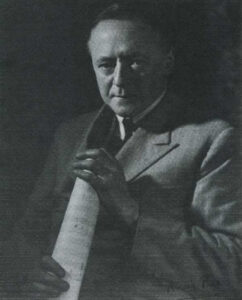Arnold Bax and the Loneliness of the Long Distance Listener by Steven Kruger
Editor’s Note: Steven Kruger’s is a former classical concert agent and a noted music critic for several publications including Fanfare and New York Arts. His full bio is below. This is his first contribution to the Arnold Bax Website.
If you are reading this, it’s probably fair to say you are experienced in unrequited love. Carrying a torch for a composer bypassed by history is like that, rendered all the more intense by one’s sense of injustice at the neglect. Music is something shared, after all, so one’s frustration is not merely personal, but imbued with a notion that the world would benefit from the works in question, if only people could be persuaded to listen….An advocate is born.
Advocates are both lucky and unlucky these days. Torch carriers for the symphonic music of a neglected figure like Arnold Bax have managed to record large swaths of his symphonies and tone poems in first rate sound. On CD an “A” piece by a “B” composer has never fared better. (It is even easy to access superb performances of music by Florent Schmitt or Alberic Magnard these days). But in the concert hall something of a dearth persists. Musical culture is always a mirror, and between edgy new music experimentation and the mainstreaming of ethnic world music, lesser known European composers from a hundred years ago are in as much danger of neglect as ever.
 Even so, many of the acknowledged great works in the traditional European concert repertoire have effortlessly survived. Orchestras and audiences have no trouble understanding and warming to pieces by Debussy and Stravinsky and Respighi and Vaughan Williams. So why don’t we run into more music by Arnold Bax on the concert stage? I think I know why. As someone who loves most of it, I wouldn’t argue that there is something exactly wrong, but I would metaphorically suggest as a primary reason that Bax is “the Henry James of music”.
Even so, many of the acknowledged great works in the traditional European concert repertoire have effortlessly survived. Orchestras and audiences have no trouble understanding and warming to pieces by Debussy and Stravinsky and Respighi and Vaughan Williams. So why don’t we run into more music by Arnold Bax on the concert stage? I think I know why. As someone who loves most of it, I wouldn’t argue that there is something exactly wrong, but I would metaphorically suggest as a primary reason that Bax is “the Henry James of music”.
Like the terminally convoluted novelist, Bax cannot resist the temptation to develop a sub-paragraph, and in the process frustrate the linearity of the listener’s ear. The subtlety and complexity which results can get in the way of the music’s immediate appeal for a concert audience. That’s probably why Bax pieces work so well in the home. When his music goes off on a tangent, we can always empty a wastebasket or brush our teeth. In the concert hall, sitting like boiled owls, we might cough and squirm. And hall managers, worrying about ticket revenue, have a way of counting coughs.
The most widely performed piece by Bax is his symphonic poem Tintagel, with its triumphant feeling of soaring and hang-gliding above coastal cliffs. It goes down well with audiences, because it features cinematic emotional uplift, majesty, a purring velvet melody and the optimistic simplicity of a man in love. A stormy central section struggles a bit with development and is probably too long, but the piece works, and audiences know it. It carries us vividly over rolling seas and refreshes us like a tonic.
Bax’s music is instantly recognizable anywhere–intriguing in its capacity for sound effects both light and deep, and for its unusual timbres and general coloration. This alone would mark Bax as a composer worth noting. If you can imagine Bruckner going crazy with full orchestra tremolos and visualize Sibelius in bardic mode taking psychedelics and getting fixated on a lava lamp, you might be close to the fascinating world Bax cooks up from the burbling stew of impressionism seasoning his efforts. Like the impressionists, Bax’s sonorities revolve around the winds, and as with Sibelius, the deep brass matter more than the strings. Debussy is a major influence, but Bax appears to go beyond the abstractions of Jeux, which is emotionally cool to a fault, or the generalized gloomy neutrality of The Martyrdom of St. Sebastian. Bax imbues genuine menace and heartbreak into his music in ways Debussy was not inclined to do. There is often a sad and cinematic woodwind lovelorness lurking in Bax’s scores, as well. And there exists by its side in his works written after the First World War a bitter anger which can occasionally come across as ugly and aggressive. All these features play into a reputation which hovers on the edge of the standard repertory.
Bax was fascinated with tone painting and, like Stanford before him, was in love with Ireland’s pagan mythology of forest creatures, eerie mists and malevolent curses. Indeed, the two composers between them left us a substantial collection of lovely windswept and mysterious pieces with evocative titles suggestive of the Irish psyche. Sadly, we will probably never hear most of them live. When it comes to Bax’s tone poems and even his symphonies, for all the beauty contained therein and for all our love of them as CD collectors, there is probably a fairly good reason why they are not more popular.
Vernon Handley hinted at it, perhaps without realizing his point, in suggesting that Ralph Vaughan Williams was ultimately a melodist and Bax a composer functioning through development. In the concert hall sweeping melody tends to trump intricate development, and Bax, as we will illustrate, could not resist the temptation to overelaborate his ideas. As a result, I expect even the most convinced Bax lover will have to admit ultimately that many pieces, for all their genius and evocative beauty, are hypertrophic.
 One of the most successful Bax tone poems is The Garden of Fand. I have to laugh a bit about just what it evokes for me. I’ve known the piece for fifty years but somehow never read the program notes telling me that the “garden” in question was meant to be the sea. For several decades I thrilled to the notion of shadowy lawns and moonlight bowers and–seven minutes in–to a remarkable passage that always reminded me of a soccer ball bouncing away from you in the dark. I still think it works fine like that! The tone poem features, just as Tintagel does, a long-limbed and unforgettable diaphanous melody, this time in the gentle high winds, which ensures the tone poem’s place in our hearts. Its irregular phrase emphasis reminds me of David Raksin’s much later composed theme for the 1952 film, The Bad and the Beautiful. The yearning in Bax’s melody seems to suggest there’s a Gloria Grahame or a Lana Turner in that garden or on those seas (in his own life it would have been Harriet Cohen). Indeed, The Garden of Fand, though written in 1916, is highly cinematic, and it’s great climax, punctuated with low brass chords straight from Florent Schmitt’s La Tragédie de Salomé, is Hitchcockian in its drama.
One of the most successful Bax tone poems is The Garden of Fand. I have to laugh a bit about just what it evokes for me. I’ve known the piece for fifty years but somehow never read the program notes telling me that the “garden” in question was meant to be the sea. For several decades I thrilled to the notion of shadowy lawns and moonlight bowers and–seven minutes in–to a remarkable passage that always reminded me of a soccer ball bouncing away from you in the dark. I still think it works fine like that! The tone poem features, just as Tintagel does, a long-limbed and unforgettable diaphanous melody, this time in the gentle high winds, which ensures the tone poem’s place in our hearts. Its irregular phrase emphasis reminds me of David Raksin’s much later composed theme for the 1952 film, The Bad and the Beautiful. The yearning in Bax’s melody seems to suggest there’s a Gloria Grahame or a Lana Turner in that garden or on those seas (in his own life it would have been Harriet Cohen). Indeed, The Garden of Fand, though written in 1916, is highly cinematic, and it’s great climax, punctuated with low brass chords straight from Florent Schmitt’s La Tragédie de Salomé, is Hitchcockian in its drama.
Something changed for Bax after WWI, though, as it did for many composers. In Bax’s case, melodies got shorter and the rhetoric of development increased and became more clotted. Bax’s seven symphonies all date from between the wars, his last written for the 1939 World’s Fair, and they form a break with the past. Unlike the early highly romantic, dreamy and erotic Spring Fire, the first three titled symphonies literally snarl with bitterness in a new sort of brass writing that is both effective and slightly unpleasant. They radiate a sort of “Yeah, right” postwar sarcasm. This corner-of-the-mouth “James Cagney” wind sonority and a new insistently carping rhythmic manner pretty much ensure a limited audience, although I have developed an acquired harmonic taste for the style. The music is tightly put together–but extremely warlike. Bax’s Second Symphony, in particular, convulses with anger and nearly blows itself up in the slow movement. The symphony contains in its entirety just one rather sad lyrical melody in the first movement, and it’s a droopy one that radiates defeat. You don’t get the girl with a tune like that. In between all the action, though, one can revel in an inventive array of tremulous creepy film noir moments. Bax is ultimately a composer of mood and very good at it.
The most beautiful moment in the early symphonies comes with Bax’s famous epilog to the Third Symphony. It may even be the most beautiful thing he ever wrote. The music walks you slowly home, a weary traveler trudging in resignation, one foot placed gently after the other. It’s a passage not entirely different in intent from the conclusion of Vaughan Williams’s Fifth Symphony, which also accompanies the listener home, holds on to his hand for an extra moment at the threshold, and then disappears inside. The difference is that Bax cannot leave well enough alone. He interrupts the walking rhythm to develop something else for a few moments. It breaks the spell. Then, fortunately, the slow pulse of the walk home recommences, and the symphony is brought to its quiet but inconclusive end. The Vaughan Williams Fifth radiates simple optimism and serenity, a feature of the consistency in its delivery. Bax’s Third leaves you wondering what went wrong in your life.
The Bax Symphonies do gradually become more optimistic in tone as time passes. The Fourth is essentially cheerful, and the Sixth is mystically beautiful and transparent, filled with lovely tintinnabulation. The Seventh is finely elegiac, albeit with an overwritten slow movement which starts out like a lovely offshoot of “Tristan” but winds up gritting its teeth with unnecessary climaxes. The third movement epilog does say goodbye, though, in just the nostalgic way Bax surely wanted. The Fifth Symphony seems to get stuck in the gloom of early Sibelius and heaves itself about heavily with no truly pleasant outcome. I’m still wrestling with how to listen to it without experiencing something between claustrophobia and depression!
Indeed, Bax symphonies come to us from a grim shadowy postwar railroad-trestle England of sooty locomotives screaming in the night, white industrial smoke and dimly lit cobblestone streets black and dreary in the rain. There is even something slightly menacing and goblinesque about the symphonies when the music purports to cavort. Misery is typical of the shell-shocked music written after the war in Europe, a war that defeated everyone, and Bax is profoundly affected by it. Listeners won’t find many happy moments in European symphonic works from the 1920s. It’s why we almost never listen to Pfitzner. And Albert Roussel’s Second Symphony, dating from 1921, must surely be among the most depressing symphonies ever composed. Even in England, Vaughan Williams surprised the world with his strangely muted Symphony No. 3, its slow movement suggesting a blood red sunset over a body strewn field. England did not feel like a victor. Add to this the 1916 Irish rebellion, and we have a setting for the downbeat nature of much that we hear in the music of Bax.
So where do we come out with this torch we are carrying down history’s tunnel? What does it illuminate? We know that Arnold Bax was a stylistic genius. We know that he had a remarkable cinematic ability to sketch a psychological mood and possessed one of the great ears for harmony and harmonic effect. We know that his melodies were always emotional and personal, something that cannot always be said of impressionists. (Scriabin’s most famous symphonic works, the Poem of Ecstasy and The Poem of Fire are utterly heartless by contrast.) Bax’s music, we know, is replete with quivering pregnant moments which evoke our sense of psychological decision, almost more interesting when evoking the flicker of an eyelash than when making a great statement. We observe a sound world he created as easy to identify as that of Respighi or Debussy, and in his best pieces we sense a “rightness” that carries the day. Elsewhere, though, we perceive an irresistible tendency to overdevelop and subdivide which, I would argue, renders the middle third of many Bax symphonic movements a trial to listen to. This prolixity, in all likelihood, will be history’s judgment and will limit Bax’s concert hall exposure, as will the tendency to put over a brass chord with a snarl. But perhaps Bax would feel as Henry James surely did that “Deep experience is never peaceful”…
Steven Kruger is a former classical concert agent. For a number of years he supervised the roster of conductors at Shaw Concerts in New York City, representing such artists as Sir Andrew Davis, Sir Neville Marriner, Rafael Fruhbeck De Burgos, Jose Serebrier and Robert Shaw.
Born in New York City to a German immigrant father and an American mother, Kruger is a descendant of 19th century Bach biographer Philipp Spitta. He was educated at Phillips Exeter Academy and Princeton, and received his degree in Philosophy, but turned to music administration after a brief career as a military officer and stockbroker.
Early in his exposure to music, Kruger developed a special fondness for the British Symphonists, and as a concert agent was able to play a part in the revival of such composers as Elgar, Delius, Walton, Bax and Vaughan Williams during the late 1970s. He continues today as an advocate for these and other 19th and 20th century neo-romantic symphonic composers, such as D’Indy, Magnard, Korngold, Schmidt and Tubin, who were at one time eclipsed by the mid-century fashion for academic music.
Now living in California, Steven Kruger is a masthead reviewer for Fanfare, America’s serious hardcover magazine devoted to recorded music, writes CD program notes on demand, notably for releases of the Oregon Symphony’s “Music for a Time of War” and “This England” series on Pentatone, and reviews selected orchestral concerts. For more than a decade until the blog folded, he contributed a regular CD review column to New York Arts twice a month called A Crop of Recordings.

